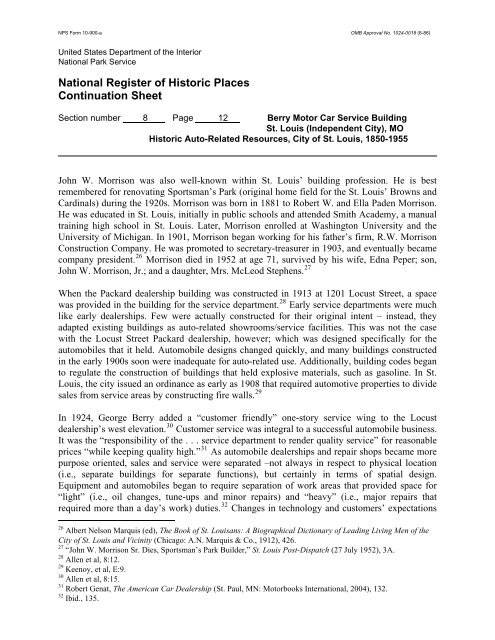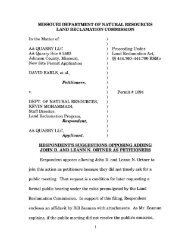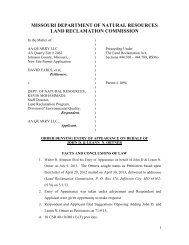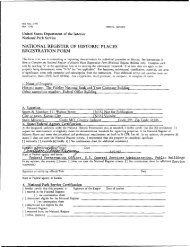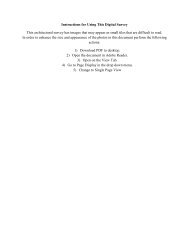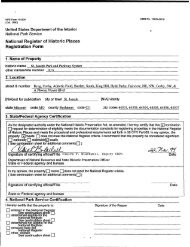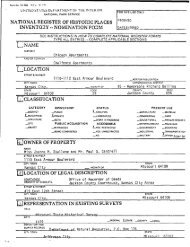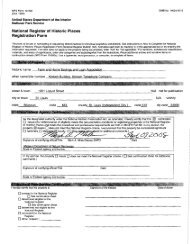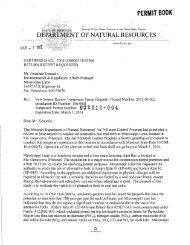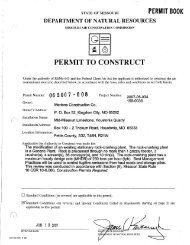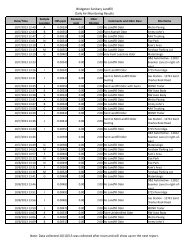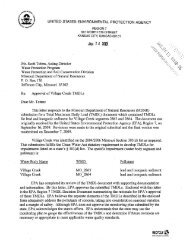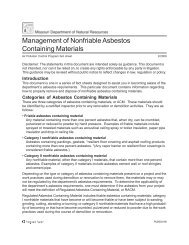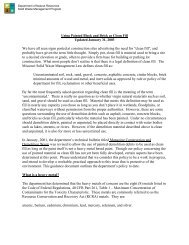Berry Motor Car Service Building - Missouri Department of Natural ...
Berry Motor Car Service Building - Missouri Department of Natural ...
Berry Motor Car Service Building - Missouri Department of Natural ...
You also want an ePaper? Increase the reach of your titles
YUMPU automatically turns print PDFs into web optimized ePapers that Google loves.
NPS Form 10-900-a OMB Approval No. 1024-0018 (8-86)<br />
United States <strong>Department</strong> <strong>of</strong> the Interior<br />
National Park <strong>Service</strong><br />
National Register <strong>of</strong> Historic Places<br />
Continuation Sheet<br />
Section number 8 Page 12 <strong>Berry</strong> <strong>Motor</strong> <strong>Car</strong> <strong>Service</strong> <strong>Building</strong><br />
St. Louis (Independent City), MO<br />
Historic Auto-Related Resources, City <strong>of</strong> St. Louis, 1850-1955<br />
John W. Morrison was also well-known within St. Louis’ building pr<strong>of</strong>ession. He is best<br />
remembered for renovating Sportsman’s Park (original home field for the St. Louis’ Browns and<br />
<strong>Car</strong>dinals) during the 1920s. Morrison was born in 1881 to Robert W. and Ella Paden Morrison.<br />
He was educated in St. Louis, initially in public schools and attended Smith Academy, a manual<br />
training high school in St. Louis. Later, Morrison enrolled at Washington University and the<br />
University <strong>of</strong> Michigan. In 1901, Morrison began working for his father’s firm, R.W. Morrison<br />
Construction Company. He was promoted to secretary-treasurer in 1903, and eventually became<br />
company president. 26 Morrison died in 1952 at age 71, survived by his wife, Edna Peper; son,<br />
John W. Morrison, Jr.; and a daughter, Mrs. McLeod Stephens. 27<br />
When the Packard dealership building was constructed in 1913 at 1201 Locust Street, a space<br />
was provided in the building for the service department. 28 Early service departments were much<br />
like early dealerships. Few were actually constructed for their original intent – instead, they<br />
adapted existing buildings as auto-related showrooms/service facilities. This was not the case<br />
with the Locust Street Packard dealership, however; which was designed specifically for the<br />
automobiles that it held. Automobile designs changed quickly, and many buildings constructed<br />
in the early 1900s soon were inadequate for auto-related use. Additionally, building codes began<br />
to regulate the construction <strong>of</strong> buildings that held explosive materials, such as gasoline. In St.<br />
Louis, the city issued an ordinance as early as 1908 that required automotive properties to divide<br />
sales from service areas by constructing fire walls. 29<br />
In 1924, George <strong>Berry</strong> added a “customer friendly” one-story service wing to the Locust<br />
dealership’s west elevation. 30 Customer service was integral to a successful automobile business.<br />
It was the “responsibility <strong>of</strong> the . . . service department to render quality service” for reasonable<br />
prices “while keeping quality high.” 31 As automobile dealerships and repair shops became more<br />
purpose oriented, sales and service were separated –not always in respect to physical location<br />
(i.e., separate buildings for separate functions), but certainly in terms <strong>of</strong> spatial design.<br />
Equipment and automobiles began to require separation <strong>of</strong> work areas that provided space for<br />
“light” (i.e., oil changes, tune-ups and minor repairs) and “heavy” (i.e., major repairs that<br />
required more than a day’s work) duties. 32 Changes in technology and customers’ expectations<br />
26<br />
Albert Nelson Marquis (ed), The Book <strong>of</strong> St. Louisans: A Biographical Dictionary <strong>of</strong> Leading Living Men <strong>of</strong> the<br />
City <strong>of</strong> St. Louis and Vicinity (Chicago: A.N. Marquis & Co., 1912), 426.<br />
27<br />
“John W. Morrison Sr. Dies, Sportsman’s Park Builder,” St. Louis Post-Dispatch<br />
(27 July 1952), 3A.<br />
28<br />
Allen et al, 8:12.<br />
29<br />
Keenoy, et al, E:9.<br />
30<br />
Allen et al, 8:15.<br />
31<br />
Robert Genat, The American <strong>Car</strong> Dealership (St. Paul, MN: <strong>Motor</strong>books International, 2004), 132.<br />
32<br />
Ibid., 135.


